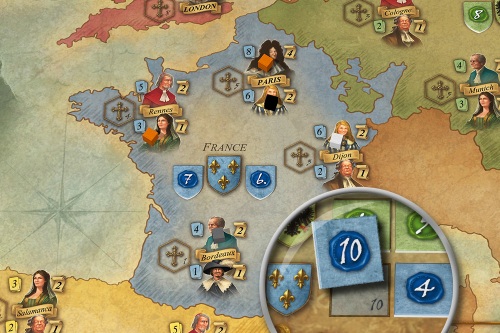
Royals

In Royals, players take on the roles of the great noble houses of the 17th century, fighting for supremacy in Europe at that time. With the help of the right Country cards, they occupy influential positions and obtain bonuses for this in the form of victory points. The higher the rank of the title associated with the position, the more Country cards required. Already-occupied positions can be contested by playing Intrigue cards.

The game proceeds over 3 periods, with a scoring taking place after each of them. During scoring, the players with the greatest influence in each of the 4 countries score victory points. After the third period scoring, the game ends with the scoring of the individual titles. The player with the most victory points wins.

Note: The official web site is not available in an English-language version, though the game's initial release is in English and German.
images © Abacusspiele
User Reviews (1)
Add a Review for "Royals"
You must be logged in to add a review.

Royals
I have long passed the days of suggesting Catan or Ticket to Ride as the perfect ‘Gateway Game’. If I’m trying to impress someone, to entice them into this wonderful hobby, my go to game has for some time been Ethnos.
Does Royals have the chops to supplant the champ?
Setting
Royals takes place in that staple setting of board games, Medieval Europe. England, France, Germany and Spain are up for grabs, and their respective nobility are there to be won over.
The board is broad and busy, a map of Europe with various little tracks and charts dotted about. Much like Ethnos, the theme is irrelevant, and could really have been anything else. If I was a betting man, I’d say the relative obscurity of Royals is down to it’s bland, generic theme.
And this is a colossal shame, because the gameplay is anything but bland.
Gameplay
To gain favour with an Earl, Princess or King, you must sacrifice cards with symbols of their respective nationalities. The higher the rank, the more cards you will need. Once you gain favour, you place a marker on their city on the board, and another marker on their respective portrait that sits off to one side. The first to impress someone in this way gains points from the city, which are not available after first being won.
To gain the necessary cards, you must pick up from a face up/face down pool, immediately familiar to players of TtR, and still a delightful little game of ‘push your luck’. Naturally, the early stages of the game see players picking up fists of cards and splurging them on easily swayed aristocrats.
But as the game progresses, the cities fill up with red and blue and yellow, and easy pickings become harder to find. Gaining influence over the nobles then requires serious investment in single suits of cards for the big fish, or some foxy intrigue.
You see, when collecting cards, players are presented with the choice of influence cards and intrigue cards. Influence is used to gain favour with the nobles and are hoovered up quickly, but intrigue cards are used to usurp nobles from others’ spheres of influence, placing your own marker with the noble. They are the choice of the long term, as the early points are already gone.
Because as the deck dwindles, all eyes turn towards the national influence points. Three times you will play through the deck, which seems daunting when first explained, but in a game that moves as fast as this, soon reveals itself to be quite manageable. At the end of each of these ‘ages’, influence in each nation is counted up and further points awarded.
Play commences again, with a reshuffled deck and a board full of influence. It’s somewhere around the middle of the 2nd age that intrigue begins to bite, and the push and pull of intrigue, usurpation and feuds really kicks in and seething resentment sometimes explodes into naked aggression.
Once the dust settles, and blood pressures come down, at the end of the 3rd age, points are allocated, counted and the person with the most is declared the winner.
Looks
Alas, all the potential Royals has in it’s simple, direct gameplay, it more than undercuts with it’s appearance. By the end of the 1st age, the board is awash with cubes, and becomes increasingly difficult to parse. You are constantly required to slide cubes to one side to see which portraits they cover, and it never becomes an easy task to work out which cities belong to which country.
In a game where 1 or 2 points of influence can have dramatic effects, this is bordering on the unforgivable.
And in a game as themeless as this, it’s bizarre they didn’t go with something truly imaginative.
Accessibility
Easy to grasp rules, sitting in a 6 page rule book place this squarely on the lower levels of complexity.
I watched a video, read the rules, and was good to go, with only a few occasions requiring a check of the book.
Conclusion
The setting is at least a little friendlier than the high fantasy orcs, halflings and minotaurs of Ethnos, but when compared to the simplicity of that modern classic, or the other Gateway heavyweight Ticket to Ride, Royals is just a bit too busy to receive unqualified enthusiasm.
A shame, as this could have been something special.
We’ll put this top of the list of games desperate for a reskin/retheme right next to Ethnos.